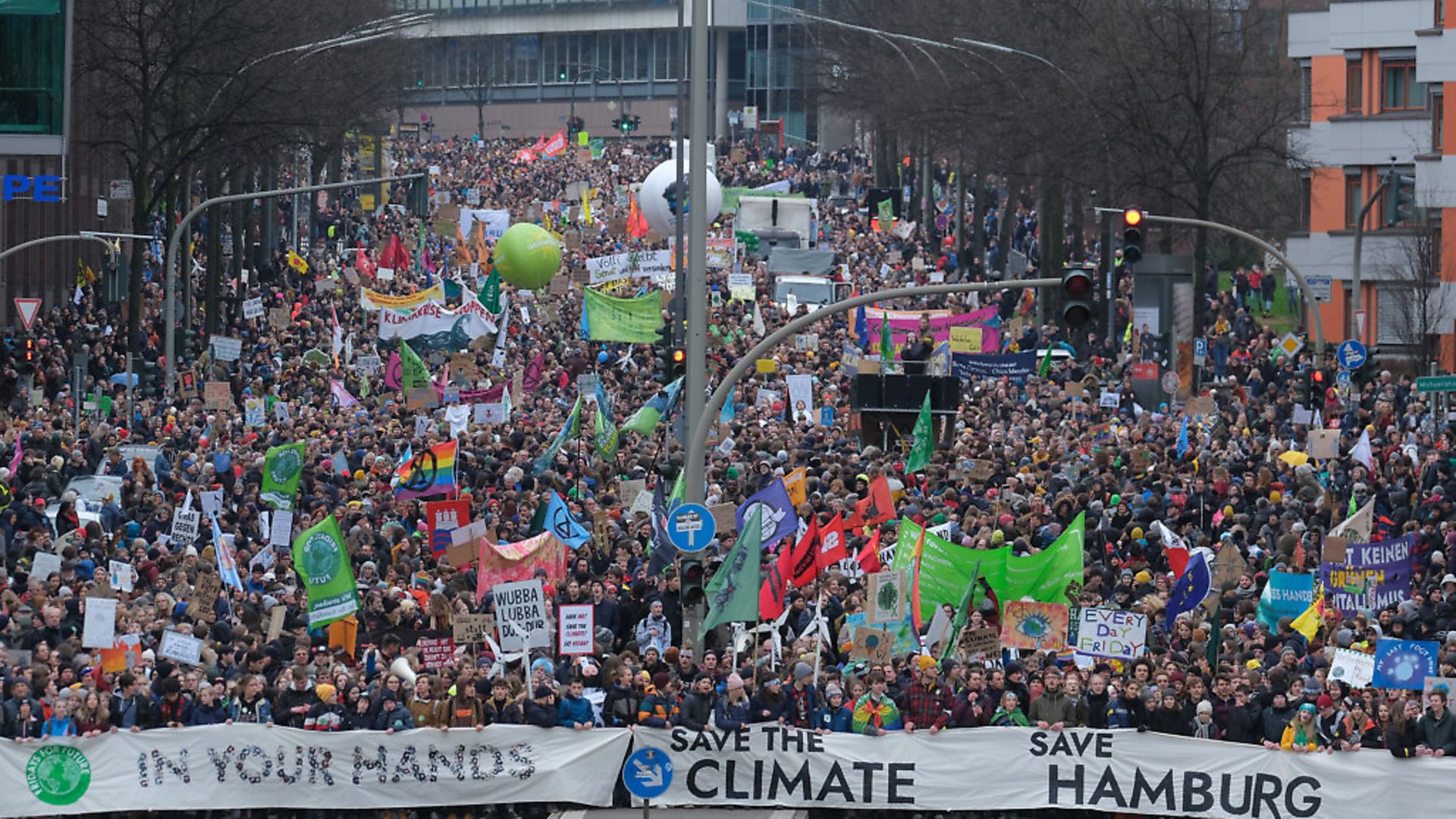
Fears about climate change are translating into serious political gains for Green parties in German-speaking countries. PAUL KNOTT reports from the region where the environmental movement is having its biggest impact
Have your say
Send your letters for publication to The New European by emailing letters@theneweuropean.co.uk and pick up an edition each Thursday for more comment and analysis. Find your nearest stockist here or subscribe to a print or digital edition for just £13. You can also join our readers' Facebook group to keep the discussion and debate going with thousands of fellow pro-Europeans.
Before Covid-19 took hold, fires, floods and extreme weather events were sparking worldwide alarm about the climate crisis. And many people will return to exhorting their political leaders to take action against this serious long-term threat once the pandemic is over – perhaps in new circumstances, where the extreme measures taken to tackle the coronavirus will have expanded the sense of what is politically possible.
As yet, though, few countries have turned their growing green sentiments into electoral support for parties that prioritise the environment.
The most significant exceptions are found in the German-speaking lands of Europe; Austria, Switzerland and Germany, where support for Green parties is growing rapidly. These countries’ proportional representation electoral systems have helped to make this success possible. But there are many other reasons for the Greens’ Germanic breakthrough that are specific to the region and each nation individually.
The Green Party has been a force for several decades in Germany, having attracted some of the more talented members of the 1960s protest generation. Former leader Joschka Fischer was foreign minister and vice chancellor in the 1998 to 2005 coalition government with the Social Democrats (SPD) that reinvigorated the German economy.
Since then, the Greens have continued to boost their standing in Germany’s powerful local and regional governments. Now led by a new, youthful generation, they are widely seen as a national governing party in waiting, as support for Germany’s traditional parties of power, the SPD and Angela Merkel’s Christian Democrats (CDU) wanes.
The Greens’ rise in neighbouring Austria and Switzerland is a more recent phenomenon.
The Green party’s Alexander Van der Bellen was elected to the largely ceremonial post of Austrian president in December 2016. More significantly, the Greens entered government this January as junior partners to the conservative People’s Party (ÖVP).
The Greens’ advances in Vienna owe something to the problems of other parties. The centre-left Social Democratic Party (SPÖ) alternated in power with the ÖVP for decades. But, as with its German SPD counterpart, the SPÖ’s struggles to adapt to a changing society and the shrinking of its industrial working class base have caused its support to fall over recent years.
The SPÖ’s decline helped Van der Bellen to reach the run-off in the last presidential election. Once there, he successfully consolidated the support of those eager to defeat his far-right Freedom Party (FPÖ) opponent, Norbert Hofer.
Until last year, the FPÖ were still, controversially, in coalition government with the ÖVP. This arrangement ended when the party leader, Heinz-Christian Strache, was caught in a sting operation and accused of attempting to sell Austrian assets to the glamorous supposed niece of a Russian oligarch, in return for illicit funding.
Even so, the failings of others do not diminish the Greens’ achievement in rising from the margins to become the party best placed to take advantage of the SPÖ’s decline and the FPÖ’s fall.
Switzerland’s Green wave surged in the October 2019 general election. The campaign was the first I have witnessed anywhere in which the environment was unequivocally a first order issue, alongside the economy and public services.
Much of the credit for pushing the environment up the agenda belongs to Switzerland’s smart and energetic Green parties. And it is ‘parties’ because in the ultra-pluralistic Swiss political system there are two of them; the radically progressive Green Party and the more centrist Green Liberals. Their combined vote share rocketed to 21% (13.2% for the Greens, 7.8% for the Green Liberals) – a remarkable number in this highly fragmented multi-party system, where the highest ranked party only scored 25%.
There is a cultural basis for the Greens’ rise in the German-speaking areas of Europe, where the centrality of health and nature issues long predates the current climate concerns.
For the Austrians and Swiss – including those from the French- and Italian-speaking regions of the country – protecting their natural splendour, melting mountain glaciers and ski resorts struggling for snow due to warming temperatures are matters of national identity.
There is more to the rise of the Greens in this neighbourhood though. As Swiss Green Party leader Regula Rytz told me: ‘There is a crisis in the traditional parties, who have become too focused on defending the current situation, the corporate interests in their networks and their own power.
‘They have moved too far away from the people, who want problem-solving, not money-making politics. Many people are therefore attracted to our analysis of how to reshape our society and the global trading system towards sustainability. They want solutions for the 21st century and not the status quo’.
Rytz credits the younger generation with providing the ‘thrust’ for the rise of green politics – the Greta Thunberg-inspired climate strikes have taken off in a big way in Switzerland. Interestingly, though, she points out that this is not exclusively a youth phenomenon, noting ‘many older people whom I speak with are self-critical about their failure to stand-up sooner and now want to show solidarity with the young’.
This sentiment chimes with the Greens’ increasingly indisputable argument that we urgently need to change the present fossil-fuel dominated economy in order to preserve our planet for future generations.
Perhaps in a further example of how the Greens are increasingly in tune with the times, Rytz acknowledges that some of their ideas for reorganising global trade can be portrayed as being ‘a little bit protectionist’. As she explains, the party is committed to international cooperation and fairness but believes we need a different form of globalisation.
It sees the current system of international trade agreements as being ‘a race to the bottom, setting low costs against sustainability’ and proposes measures to bring about higher ecological and social standards, more cost-effective transport and thus a strengthening of the local economy.
There is a tendency to identify the Greens with left-leaning, younger radicals. But it is possible to imagine how their proposals on conservation and boosting local agriculture could eventually help them to make inroads into the largely conservative rural electorate too.
The other environment-focused party in Switzerland, the Green Liberals, are certainly pitching to different voters.
As the executive director of the Green Liberal parliamentary group, Ahmet Kut, says: ‘Our party’s programme is right there in the name.’
They are a socially and economically liberal party. In their view, environmental sustainability can be achieved by leveraging the strengths of the market economy, rather than overturning it or tying it down with regulation.
The Green Liberals advocate putting an accurate price on resource consumption, such as carbon use. The proceeds would then be steered towards green technology research and mitigating the high initial costs of transition to renewable energy sources and cleaner modes of transport. Kut points out that ‘much of the technology needed to achieve sustainability is actually already available. The problem is often the high initial cost of installation. We need to create financial incentives to help people to make the switch’.
The Green Liberals use their contacts with companies to emphasise that environmentalism, as well as being virtuous and essential, is also ‘a business opportunity for a country like Switzerland, which has plenty of financial resources and an exceptionally innovative engineering sector’.
While the Green Liberals do not fit neatly into the alliance of green parties across Europe (instead, they are a member of the ALDE group of European liberals), Kut cites Winfried Kretschmann as an inspiration. Kretschmann has been the minister-president of the German state of Baden-Württemberg since 2011 – a remarkable feat for a Green politician in a predominantly conservative region and car industry heartland.
Kretschmann pursues his aim of ‘implementing a process of social and ecological renewal of the State’ while maintaining a cooperative relationship with the business world. This makes him a model for the Green Liberals, even if the minister-president would certainly consider himself more closely aligned with their Green Party counterparts.
The various green parties in this part of Europe are playing an important role in driving change to tackle the climate emergency. The Greens are stimulating young and concerned older voters with their transformative but achievable ideas. And the Green Liberals are attempting to expand green politics into areas of society that might otherwise be more reluctant to embrace environmentalism.
The region’s green parties look set to continue their rise. Their presence in government in Austria is likely to be matched in Germany and Switzerland over the next few years. In other European countries where green political influence is less advanced and which do not have proportional representation, following the same trajectory will be more difficult.
Greens in those places may need to work in conjunction with existing political parties – and make use of the expanded sense of political possibilities that is likely to be a legacy of the measures taken to counteract Covid-19.









